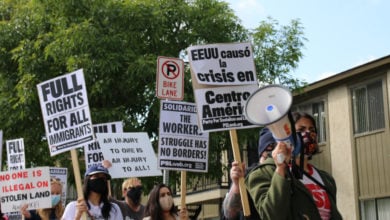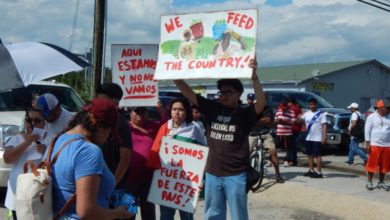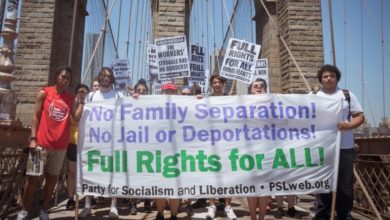When construction began recently on the Smithsonian Institute’s new Museum of African-American History and Culture, it represented a milestone in the fight for recognition of Black Americans’ struggles and contributions to the country. There was one glaring problem, however: among the many construction workers at the site, almost none were Black.
This was a particularly galling indignity to the Black residents of Washington, D.C., known as the “Chocolate City.” But it was not unusual. Instead, it was indicative of the endemic discrimination in the city’s construction industry, which has boomed during the past decade. Of the thousands of jobs created, very few have gone to Black residents in the city. That the construction boom has been built largely on the gentrification of majority Black neighborhoods has added insult to injury. Not only have Black residents lost their homes and communities, they have been largely shut out of the city’s so-called “renaissance.”
In the “New D.C.” poverty is chiefly distributed in the “east of the river” Wards 7 and 8. These are majority Black areas, and the center of the city’s unemployment crisis. In both wards, unemployment in the past several years has been around 20 percent, and Ward 8 is reported to have a poverty rate of 35 percent. The impact of mass incarceration is also felt deeply. Unemployment among those with criminal records stands at 50 percent. The other half are almost totally restricted to six low-income job categories.
The “good jobs” of the construction industry are thus desperately needed and desired by local Black workers. The industry’s jobs are dominated, however, by Latino immigrant workers. This sort of segmentation within the workforce creates practical challenges to the implementation of “Black-Latino unity” as it directly puts workers at odds as communities and can give rise to a range of antagonistic sentiments on all sides.
For “Black-Latino unity” to become a widespread sentiment, it has to present itself not just as a slogan but a strategy for working-class victory. The battle over Washington, D.C. construction jobs thus has national importance for organizers and revolutionaries trying to make that sort of unity a reality.
Existing struggles
The industry’s discrimination against Black workers has given rise to an organization called “D.C. Jobs or Else,” which has brought hundreds of unemployed Black workers to protest discriminatory contractors, including those at the African American Museum.
The issue has also generated favorable, if not terribly effective, D.C. Council legislation. The District passed a law known as “First Source,” which requires that 51 percent of any new hires go to D.C. residents on projects that receive between $300,000 and $5 million from the city. For projects over $5 million, at least 20 percent of journey-worker hours, 60 percent of apprentice hours, 51 percent of skilled laborer hours and 70 percent of common laborer hours must be allocated to D.C. residents.
While these campaigns are only related to residency, and are not formally race-specific, they are widely understood as efforts to win jobs for the Black unemployed. The vast majority of hired construction workers, whether white or Latino, live outside the District, in Maryland or Virginia.
Washington’s elite, in the guise of developers’ organizations, have launched legal challenges to this legislation, proclaiming their right to hire who they please. Capitalist groups also fought hard to defeat a bill before the Council to limit the ability of employers to inquire into a criminal record of new hires.
The role and potential of labor unions
Most of the big construction projects in the city are done by unionized labor. This has raised the question of what role labor will play in responding to both the needs of their employed membership and those of the surrounding Black communities.
Labor unions in the District have taken a stand in favor of laws like First Source that are aimed at the employment of Black workers. Various building trade unions have also put notable efforts into expanding apprenticeship opportunities for Black workers. The Laborers Union local, which has a primarily Latino membership, has endorsed and shown concrete solidarity to the D.C. Jobs or Else campaign, and their protests.
Such visible labor support counteracts the efforts of anti-immigrant and anti-labor demagogues to channel the righteous anger of unemployed Black workers against Latino immigrants or unions. Undoubtedly, more could be done. A key breakthrough would be for union workers to conduct job actions, and even refuse to work, where contractors are discriminating. Fighting for non-discriminatory hiring practices in their contracts would reveal to all how labor unions can be the most effective vehicle to overcome the divisions within the working class.
Combating racism in the labor market
The theoretical job market-in which there is one general pool of jobs and every one has a more or less equal chance based on their qualifications—does not exist. In reality, the labor market under capitalism remains largely organized on racist and sexist lines. It is deeply discriminatory, but it also takes the form of self-reproducing “job niches” as individual workers then recruit from their personal networks and communities to fill available jobs.
In the post-Civil Rights period, the public sector has been the key “growth industry” for Black Americans. At the same time, private employers’ racist stereotypes about Black workers—documented in countless studies—have closed off job opportunities, leading to skyrocketing unemployment. In many industries, employers have instead turned towards the more vulnerable and precarious immigrant workforce.
The capitalists’ unrestrained control over hiring and firing — at-will employment — sets the basis for sectors of the working class to compete for scarce jobs. Struggles that mandate the hiring of Black workers or deny the ability of employers to search criminal records, therefore, limit the power of employers to define employability within narrow, racist limits. This is in the long-term strategic interest of all workers, including the currently employed Latino workers.
Likewise, the fight for full equality for all immigrants strikes at the ability of employers to use citizenship status as a weapon to super-exploit Latino workers. It would strike a blow to the caste divisions within the U.S. labor market, which has so regularly degraded Black workers. Workers’ organizations can play the critical role in fusing together the struggles of these historically oppressed communities, pointing them toward a common enemy, and raising the political consciousness of the members through the process of struggle.
Not just jobs, a new society
Ultimately, the fight to limit the capitalists’ control over hiring – what is called “at-will employment” – must become a battle to overthrow it altogether. Capitalists not only hoard the social wealth, but also deploy it only for the purposes of profit. There are many jobs to be created outside of the narrow profit interest – in the fields of infrastructure, education and health care, as well as the cultural and social spheres. The wealth exists to create a guaranteed standard of living for all, thereby eliminating the social basis for racialized job competition.
In other words, the discussion about Black-Latino workers’ unity must advance beyond the campaigns for existing jobs, as dictated by the capitalist elite. It must point the way toward putting the social wealth under the control of poor and working people and the construction of a new socialist system that guarantees a humane, dignified and sustainable life to all.






